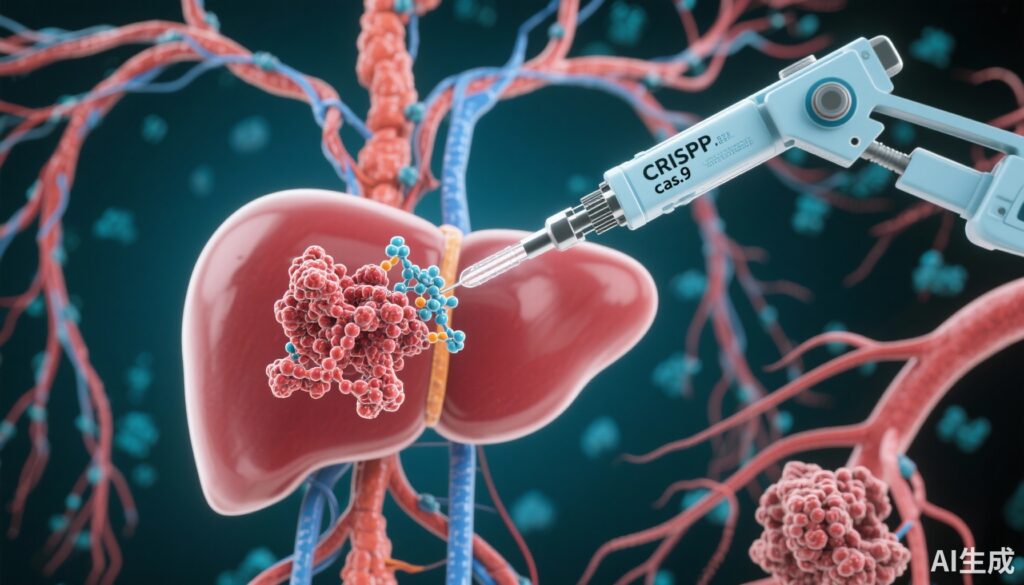Study Background and Disease Burden
Hereditary transthyretin amyloidosis with polyneuropathy (ATTRv-PN) is a rare, progressive, and fatal multisystem disease characterized by the extracellular deposition of misfolded transthyretin (TTR) amyloid fibrils, primarily affecting peripheral nerves. This leads to debilitating sensorimotor and autonomic polyneuropathy, significantly impairing quality of life and survival. Conventional therapies have limitations in halting disease progression and are often accompanied by treatment burdens. Consequently, there remains a pressing clinical need for disease-modifying therapies with the potential to sustainably suppress TTR production and mitigate amyloid deposition.
Nexiguran ziclumeran (nex-z), an investigational in vivo genome editing agent, utilizes CRISPR-Cas9 technology to selectively inactivate the TTR gene in hepatocytes, the primary source of systemic TTR. This novel approach aims to deliver a one-time infusion for rapid, durable TTR suppression, differentiating it from RNA interference or antisense oligonucleotide therapies that require repeated administration.
Study Design
The article reports a phase 1, open-label, single-arm trial evaluating the safety and pharmacodynamics of nex-z in patients diagnosed with ATTRv-PN. Thirty-six participants received a single intravenous infusion of nex-z, with a mean follow-up duration of 27 months. Primary endpoints focused on safety and pharmacodynamic measures, particularly serum TTR levels. Secondary efficacy endpoints encompassed clinical progression markers: the familial amyloid polyneuropathy (FAP) stage, polyneuropathy disability (PND) score, serum neurofilament light chain (NfL) as a biomarker for neuroaxonal injury, modified body-mass index (BMI) adjusting for nutritional status, and the modified Neuropathy Impairment Score+7 (mNIS+7), a comprehensive neuropathy severity metric ranging from 0 (no impairment) to 304 (maximal impairment).
Key Findings
The study demonstrated a profound and rapid reduction of serum TTR by a mean of 90% from baseline at day 28, with sustained suppression maintained at 92% reduction through 24 months post-infusion. This level of durable biochemical knockdown is unprecedented in gene-editing approaches for ATTRv-PN.
In terms of safety, infusion-related transient reactions were common (observed in 21 patients), predominantly mild to moderate. Other treatment-related adverse events included reduced serum thyroxine in 8 patients without clinical hypothyroidism or elevated thyrotropin levels, and headaches in 4 patients. Serious adverse events occurred in 11 patients, including one death due to cardiac amyloidosis progression and one withdrawal due to motor decline; causality with nex-z was not definitively established.
Clinically, at 24 months, 29 patients maintained stable FAP stage and 27 patients had stable PND scores, with some showing improvement (2 in FAP stage; 5 in PND score). A minority experienced disease worsening (2 in each category). Serum NfL levels decreased by a mean of 9.0 pg/mL indicating reduced neuroaxonal damage, while modified BMI improved by an average of 24.7, suggesting nutritional stabilization or gain. The mean mNIS+7 score improved by 8.5 points, reflecting an overall amelioration of neuropathic impairment.
The robust biochemical TTR reduction correlated with clinical stabilization or improvement in multiple measures, underscoring the translational potential of the gene-editing approach.
Expert Commentary
The study by Gillmore et al. is a landmark evaluation of in vivo genome editing in a human inherited amyloidosis, leveraging CRISPR-Cas9’s specificity for hepatic TTR gene silencing. The single-dose administration with prolonged biochemical effect challenges traditional paradigms requiring chronic suppression therapy.
While encouraging, these data arise from an open-label phase 1 study without a control arm, limiting definitive efficacy conclusions. The safety profile appears manageable but requires validation in larger cohorts. Moreover, the observed serious adverse events, including one death, highlight the need for vigilance regarding potential cardiac amyloid complications independent of or related to therapy.
Biologically, the study bolsters the mechanistic premise that TTR reduction can slow or reverse neuropathic progression, as supported by serum NfL and mNIS+7 improvements. The study dovetails with evolving gene therapy modalities aiming for durable cures rather than symptom management.
Future investigations should focus on randomized controlled trials, diverse patient populations with varying disease stages, and longer-term follow-up to delineate durability, late adverse events, and impact on cardiac amyloidosis manifestations. The gene-editing platform may also open broader avenues for hereditary amyloidoses and other protein misfolding disorders.
Conclusion
The Nexiguran ziclumeran phase 1 study reports a groundbreaking advancement in hereditary ATTR with polyneuropathy, achieving rapid, sustained suppression of serum TTR after a single infusion. Associated clinical metrics indicate potential disease stabilization and improvement, with an acceptable safety profile. These findings support continued development and larger trials of nex-z as a transformative gene-editing therapy for this devastating disease. The study exemplifies the clinical promise of CRISPR-Cas9–based therapeutics for systemic proteinopathies and neurodegenerative conditions.
References
- Gillmore JD, Gane E, Täubel J, et al. Nexiguran Ziclumeran Gene Editing in Hereditary ATTR with Polyneuropathy. N Engl J Med. 2025 Sep 25. doi: 10.1056/NEJMoa2510209. Epub ahead of print. PMID: 41002250.


